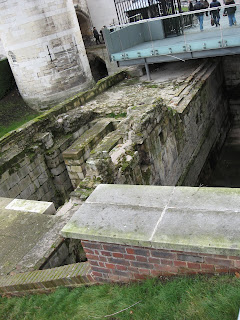
The last was of Parliament and Big Ben, and here's Westminster Abbey across the street. I didn't pay to go inside this time because I wanted to fit a lot of places in, and it was 15 pounds. Westminster Abbey started in 960 AD, but this building wasn't built until 1245 AD:

After that I went back on the tube to the Tower of London, and this time I've got a picture with myself in it. No one told me to smile, so I didn't.

The Tower started as just one of the buildings, the White Tower, in 1078 by William the Conqueror. Different kings added more and more to it until it became basically as we see it today in the late 1200's. It was a fortress, palace, and prison, complete with torture chambers. Here are the remains of the drawbridge over the moat:

And a closer look at the drawbridge:

And beside the Tower of London, Tower Bridge, which is often mistakenly called the London Bridge:

Again, the Tower cost money and I knew I wouldn't have time for everything I wanted to do so I didn't go in this time, but will some day. I went next to the Imperial War Museum on the recommendation of a friend, and it was well worth it.

There were so many authentic military vehicles and equipment inside that I can't post all the pictures, but here are a few favorites. First, an actual World War 2 German one-man submarine:

The casing of a US atomic bomb, identical to the Little Boy that was dropped on Hiroshima.

A German V-2 rocket (imagine this bad boy landing in your yard...):

There was a lot to see there, including exhibits on the British intelligence agencies and their actions in different wars. The Holocaust exhibit was... well, hard to explain, really. No pictures are allowed inside so I don't have any of it. Quotes from many German officers and politicians about the Jews were posted all over the walls. After that I knew I was almost out of time and had to leave, so while I saw everything, some of it was very fast.
By the time I got to the tube station next to the two museums I had left to go to, it was only 45 minutes before I had to meet my professor at the British museum so that we could go around and look at a couple of the exhibits for an hour before the lecture, so I didn't get to the Soane museum. Still, the British museum was definitely the best part of the day. Here's the entrance with a classic telephone booth outside:

There was so much to see inside that I'm glad I spent at least the 45 minutes inside to look at parts I knew I wouldn't see with my professor. She only planned on going through the ancient Greek and Enlightenment sections with us. First of all, the inside entrances to each area are also set up in ancient fashion:

Like I said, I really enjoyed the museum, especially because it had so many authentic artifacts. First of all, the actual Rosetta Stone:

Egyptian hieroglyphs:

An Egyptian sarcophagus:

Roman mosaics:

And now I've finally seen mummies---cross another thing off the life goal list. This one is one of the Cleopatras:

I don't know who this is.

Then it was on to the Roman section, which was smaller. Unfortunately I don't remember which Roman Emperor this was, but I think it was Emperor Septimius Severus who I wrote a paper about and presented on. He was good at conquering, but his wife essentially ran the political side of things.

After that I went down to meet my professor and tour the Greek and Enlightenment areas. The British Museum also has the ancient Nereid monument from almost 400 BC, taken from Lykia:

Here are some of the statues from one of the pediments of the Parthenon, built in the 5th century BC:

And more from the Parthenon:

Well believe me I have plenty more where these came from, but that's all I'll put up since I know it's a lot. The lecture was good, and afterward it seemed a little bit of a higher-society deal with the many wines and drinks that were served by extremely well dressed people. Thankfully they also had water. I had no idea what to do with my glass when I was done though so I just took it up to the counter in the corner and the lady gave me a look and then took it. After the lecture I went around the museum for a little longer before it closed. I didn't even see half of the museum and so I will definitely be going back again.











